
MAY CONTAIN NUTS

Search Shorpy
SHORPY ART

Framed or unframed, desk size to sofa size, printed by us in Arizona and Alabama since 2007. Explore now.
Join and Share
Ad-Free Shorpy
Shorpy is funded by you. Patreon contributors get an ad-free experience.
Learn more.

Recent comments
- Those standpipes
- Wrenches
- International D-40 I believe
- Job prospects
- You had me at Train
- Land of the free
- Broad-Exchange Bldg
- Parking innovation
- The old block
- "Peck turned a sweet propeller"
- National Bank Building
- Notch shot
- Straight ahead (right, left, left, right)
- Ship lifespans
- New service
- You Say Station, I Say Potato ...
- Iron Age
- Thank you, Cornelius Vanderbilt
- Grand Central Terminal
- If they made a movie of it
- Obsolete by then.
- Half the tonnage at the NYPANO dock
- Ravages escaped, bank notes signed and dated
- Chatham expansion
- Steepled in History
- Made by York
- No Summer Vacation
- Wait a minute ...
- $$$
- Joad on the Road
Member Photos
The Shorpy
Printporium
Printporium
Search Shorpy
Search results -- 30 results per page
- Evergreen: 1938
- ... Yellow fever originated in water storage containers in New Orleans and elsewhere, if they were above ground. They were outlawed, ... Posted by Dave - 08/30/2012 - 11:06am -
![Evergreen: 1938 St. John the Baptist Parish, Louisiana, 1938. "Evergreen -- Wallace vicinity. Structure dates from 1835. Abandoned. Canal Bank Liquidators." 8x10 inch acetate negative by Frances Benjamin Johnston. View full size.
Old bonesThat indoor plumbing setup is so cool! Would love to explore the old bones of this structure.
Weather vane?Check out the glass globe up on the roof weathervane. Surely someone on Shorpy must be able to explain its function.
[That's a lightning rod. The glass balls were purely decorative, though it was once thought they served the purpose of indicating a lightning strike by shattering.]
It didn't stay abandonedThe shot above is the back of the plantation house on Highway LA-18 in Edgard, near Wallace. The restored plantation is open for tours Monday through Saturday. It consists of 29 antebellum buildings, including 22 slave quarters, plus 8 other buildings. Below are current pics of the remodeled back (roof work in progress) and front of the main house.
Rainwater collectingWhat a great example of rainwater catchment. This is becoming more popular today as a way to water plants and gardens. Collect water from a building gutter system for use later. Back when this was thought up it was more likely used for indoor water access, of course.
Thanks to Larc for noting that this place still exists. I'll add it to my list of places to see in LA.
Kind of high on this houseThe widow's walk on the rooftop most likely is high enough to see the canal that runs through that part of the state, but I'm supposing it was more architectural form than function. But maybe it was useful for the lady of the house to see how near her sternwheeler or barge captain-husband was for docking, so she'd know when to draw some water from the cistern to heat for cooking dinner. Lakes Pontchartrain and Maurepas with the serious boats would be too far away, I think.
Yellow feveroriginated in water storage containers in New Orleans and elsewhere, if they were above ground. They were outlawed, eventually, in cities, to reduce and then prevent fever outbreaks and discourage aquaphilic nuisance insects generally.
If stagnant rainwater-gravity-tower systems are coming back, well, perhaps mosquito-vectored diseases will become more common, just as bedbug infestations are spreading due to the DDT ban.
This beautiful building was preserved, thankfully, sans the water tower!
Lop off a bit here, add a bit thereThe rainwater storage containers are gone, but the in-ground cisterns are still clearly visible. I wonder if they've been sealed and repurposed as planters or something. Looking at the other LOC photos from this set, it appears that the renovations were extensive, and more an expression of someone's architectural vision than an accurate historical restoration (i.e. the new house, while beautiful, barely resembles the old house - at least on the outside).
[Some of the latter-day additions (the bay, for instance) were subtracted. So I suspect the house's current footprint more closely resembles the original than its 1930s incarnation. On the other hand, the sleeping porches at the rear have been enclosed. - Dave]
- You may be right. For more on the history of Evergreen, see this history (PDF) from the National Register of Historic Places, and this history (TIFF) from 1993 (Click here for the rest of the architectural drawings from 1993). Seems the house was built circa 1790 (looking much like this neighboring house), extensively remodeled in the 1830s, then remodeled again in the years leading up to its abandonment in the 1920s. While the current configuration might more closely resemble the 1830s version, no one knows for sure, as the only documentation of the building from that era is the building contract.
(The Gallery, F.B. Johnston)](https://www.shorpy.com/files/images/SHORPY_01443a.thumbnail.jpg)
- Nettie Quill: 1906
- ... for Capt. John Quill in 1886. Was lost in a hurricane at New Orleans in September 1915.
Internettie Nettie Quill was photographed ... Posted by Dave - 08/08/2012 - 3:12pm -
![Nettie Quill: 1906 Mobile, Alabama, circa 1906. "River packet Nettie Quill." 8x10 inch dry plate glass negative, Detroit Publishing Company. View full size.
???What's the box-like thing strung between the smoke stacks? BTW, everyone here looks happy except the guy on the right.
[A little cotton bale. - Dave]
Can we ID the square-rigger on the right?Nice tight furl on the sails.
[It's the __er Black. - Dave]
Info packetBased out of Mobile and built for Capt. John Quill in 1886. Was lost in a hurricane at New Orleans in September 1915.
InternettieNettie Quill was photographed many times. More of her here.
TiredNettie has a lot of deferred maintenance.
(The Gallery, Boats & Bridges, DPC, Mobile)](https://www.shorpy.com/files/images/4a13426a.thumbnail.jpg)
- Back in the Day-O
- Circa 1903. "Unloading bananas at New Orleans." Final installment of a thrilling trilogy we've watched unfold ... to exist in 1970.
(The Gallery, Boats & Bridges, DPC, New Orleans, Railroads) ... Posted by Dave - 08/20/2014 - 11:34am -
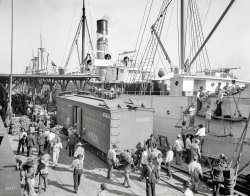
- Stair Noir: 1925
- Circa 1925. "Stairway in the old Ursuline convent, New Orleans." 4x5 nitrate negative by Arnold Genthe. View full size.
... that could be told.
(The Gallery, Arnold Genthe, New Orleans) ... Posted by Dave - 03/07/2014 - 9:28pm -
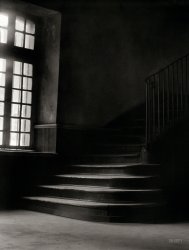
- Dauphin Street: 1906
- ... of multitasking.
Also can't help but notice the New Orleans style wrought iron balconies and living quarters upstairs over the ... rounded steeple here , here , and here .
The "New Orleans style wrought iron balconies" are actually found all along what was ... Posted by Dave - 09/08/2012 - 11:57am -
![Dauphin Street: 1906 Mobile, Alabama, circa 1906. "Dauphin Street." Shoes to the right, hats to the left. 8x10 inch dry plate glass negative, Detroit Publishing Company. View full size.
110 In The ShadeI'm guessing that the roll down shade that is shielding the storefront windows of "Schwartz The Hatter" (also a guess) is keeping the fierce Alabama sun from baking or discoloring the merchandise.
When the world was youngI rather miss the Main Streets and endless assortments of specialty shops from my youth, as pictured in this photo. I miss the sidewalks and greeting familiar people, crossing small streets and stopping for a soda or cone at the sweet shop. The town in which I was raised was still like this in the early 1950's but is now a restored Disney-like collection of antique boutiques and curiosity shops. The newer stores are "big box" emporiums surrounded by huge parking lots where one can buy everything from dogfood to diamonds, tires to tofu. I find them overwhelming and much prefer the "one thing at a time" simple life as I am incapable of multitasking.
Also can't help but notice the New Orleans style wrought iron balconies and living quarters upstairs over the businesses, which add a soft touch of hominess and humanity.
Bienville Square on the LeftRoyal Street is the next cross-street away and you can also see the building with the rounded steeple here, here, and here.
The "New Orleans style wrought iron balconies" are actually found all along what was once the French Gulf coast; many cities along this coast are older than New Orleans, including Mobile, the first capital of French Louisiana.
Here's Dauphin Street, circa 1940, probably around Christmas time, from two blocks behind today's photo, then further around the left corner in the 1930s:
WirelessI don't see a contact wire running above the track, so I surmise that this is for either a horse car or a railroad.
[The contact wire is there. -tterrace]
TodayView Larger Map
Sign says Dauphin and St. Joseph's, but not much remains. I wonder if there was a fire or something?
Maybe notjasonepowell:
>Sign says Dauphin and St. Joseph's, but not much remains.
>I wonder if there was a fire or something?
I don't know... It looks to me like that's the same building on the left, only now "boxed in."
(The Gallery, Mobile, Stores & Markets)](https://www.shorpy.com/files/images/SHORPY_4a17938a.thumbnail.jpg)
- Mal Temps: 1920
- Circa 1920. "Two-story houses, New Orleans." One of the Crescent City's grittier, grainier corners. 4x5 ... the evergreen quote:
“Times are not good here (in New Orleans). The city is crumbling into ashes. It has been buried under a lava ... the rest of the story
(The Gallery, Arnold Genthe, New Orleans) ... Posted by Dave - 10/02/2013 - 10:37am -
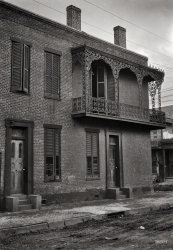
- Canal Street: 1907
- New Orleans circa 1907. "Canal Street." Center stage: A Streetcar Named ... as "The Roar of the Four".
(The Gallery, DPC, New Orleans, Streetcars) ... Posted by Dave - 10/15/2020 - 10:50am -
![Canal Street: 1907 New Orleans circa 1907. "Canal Street." Center stage: A Streetcar Named Prytania. Composite image made from two 8x10 inch glass negatives. View full size.
Expensive healthcareIt is probably no coincidence that a Loan Office is in the same building as the National Dental Parlors.
Tooth-hurty1907 dentistry on an industrial scale ... now there's an appealing idea! "Those are screams of joy, kids -- no worries!" My mother recalls her 1930s visits to a dentist named Dr. Carpenter. Guess what sort of tools he used?
Details about the photoOf the five tracks in this view, only the two outer tracks were dual gauge. Actually, you can see it, just vaguely. It's the right-hand rail that was dual, and it looks like the railhead is wider. That's the effect of the double right-hand railheads next to each other (with just wheel flange clearance between them).
We can date the photo to no later than 1904. In that year, by Louisiana law, all vestibules had to be enclosed. I suspect it dates from 1900-1904.
[It was taken the same day as this view, whose negative is marked with a copyright date of 1907. - Dave]
The car with the Prytania clerestory sign was presumably assigned usually to that route, but is not at that moment on that route. A Prytania car would not be on that track. Note the Special sign hanging from the dash. I believe the car is on some kind of special assignment, perhaps a charter.
A Streetcar Named PrytaniaAs cool a photo as I've seen in a long time. Thank you, Dave
Drip - Drip - DripEarly streetcars and interurbans did not have sealed wheel and axle bearings. The result was that lubricating oil leaked out onto the pavement. You can readily see in these two photos which tracks were the busiest. San Francisco's Market Street had four streetcar tracks, and was known colloquially as "The Roar of the Four".
(The Gallery, DPC, New Orleans, Streetcars)](https://www.shorpy.com/files/images/SHORPY-Canal_Street_1.thumbnail.jpg)
- Rail Disaster: 1933
- ... and on the Louisville & Nashville from Montgomery to New Orleans.
This particular train would have originated in Penn Station ... Posted by Dave - 07/02/2014 - 8:18pm -
![Rail Disaster: 1933
GRAVE OF MUD
WASHINGTON, Aug. 25, 1933 -- While thousands worked to overcome the havoc wreaked by the storm in the Capital, 300 trainmen struggled with the wreck of the Crescent Limited. The crack extra-fare express was hurtled yesterday from the tracks of the Pennsylvania Railroad when flood waters undermined the central abutment of the bridge over the Eastern Branch [Anacostia River], just inside the District. All day and all night the crews of railroad men worked, first with acetylene torches to clear debris from the approaches to the bridge, and then with three cranes to lift aside the wrecked cars. Late in the evening a derrick lifting the crushed engine from a grave of mud uncovered the body of the engineer, Arthur H. Bryde, of Washington. The body of J.H. Faye, the fireman, of Havre de Grace, was recovered earlier in the day. It had been ground into the mud of the embankment by a coach.
August 1933. Washington, D.C. "Crescent Limited train wreck." Another look at this wreck. Harris & Ewing Collection glass negative. View full size.
Men dead; locomotive saved.It's a K-4 Pacific type, seen many times on this site. Don't know what number it is, but it was definitely rebuilt. The first K-4 to be scrapped was #8309 in 1938, after a different wreck which occurred in Pittsburg when it plummeted off a high fill and then dropped another fifty feet over a concrete retaining wall into one of the city streets. The leading truck of the K-4 seen above is sunk in the mud dead-center of the photo.
Wrong truckOn a railroad, a truck is the assembly of wheels, springs, brakes, and centering devices which ride on the rails, supporting and guiding the car or locomotive it supports.
The engine is unmistakably, as pointed out, a Pennsylvania Railroad K-4 class 4-6-2 Pacific.
But, neither of the two trucks visible near the center of the photo came from that engine. K-4 pilot trucks were inside bearing. Perhaps, these were from under the tender, or from one of the passenger cars.
Re: Wrong TruckI stand corrected; how I missed them being outside bearing I have no idea. They probably are from beneath the tender, as the lead truck there is missing. Doubt they're from a car, as those appear to be all heavyweight equipment with six-wheel trucks.
LocomotivesWasn't the "Crescent" usually pulled by a Southern RR locomotive?
PRRA Southern 4-6-2 would pull it south of Washington. Guess this wreck must have been at the PRR bridge at 38.917N 76.9435W, where a PRR engine would pull the train.
Re: Re: Wrong truckThey are definitely Tender trucks. PRR Class 2D-T4 to be precise.
Crescent Question"Wasn't the "Crescent" usually pulled by a Southern RR locomotive?"
The Crescent Limited operated from New York to Washington on the Pennsylvania Railroad, on the Southern Railway from Washington to Atlanta, on the Atlanta & West Point / Western Railway of Alabama from Atlanta to Montgomery, AL, and on the Louisville & Nashville from Montgomery to New Orleans.
This particular train would have originated in Penn Station behind an electric locomotive (probably a PRR P5). PRR steam replaced the electric in Wilmington, DE; a Southern Railway Ps4 would take over in Washington (there may also have been an engine swap midway to Atlanta in Salisbury, NC). In Atlanta, WofA 190 or A&WP 290 (which were purchased specifically to haul this train) would take over, and an L&N locomotive would the train on the final leg of the journey.
(The Gallery, D.C., Harris + Ewing, Railroads)](https://www.shorpy.com/files/images/SHORPY-37162a.thumbnail.jpg)
- Canal Crossing: 1957
- Anyone who's ever been to New Orleans in the summer knows that it rains about once per hour, followed by ... weather. On June 15, 1957, I made a short stopover in New Orleans en route to ROTC Summer Camp. Shooting the original Kodachrome I ... Posted by prrvet - 03/18/2018 - 3:22pm -
![Canal Crossing: 1957 Anyone who's ever been to New Orleans in the summer knows that it rains about once per hour, followed by hot, sunny, humid weather. On June 15, 1957, I made a short stopover in New Orleans en route to ROTC Summer Camp. Shooting the original Kodachrome I at ASA 10, most of the slides I took in the rain came out overexposed, something practically unheard of in those days of slow speed film. But somehow I lucked out on this particular exposure, catching the pedestrians dashing between the raindrops with the sun peeking out overhead on Canal Street at St. Charles. 35mm Kodachrome by William D. Volkmer. View full size.
Active streetNice mixture of colors and bustling people plus that wonderful trolley. The sedan on the left is similar to my first car, a 1956 Chevy with white front fenders, instead of the usual blue I've seen in other places.
Movin' on UpI believe that tall white building in the center of the photo is now the Ritz-Carlton, and at the time of the picture was the Kress building.
[The tall white building is the Maison Blanche department store; the Kress building is the shorter building immediately adjacent with the vertical "Kress" sign. They're both now part of the Ritz-Carlton. -tterrace]
Otherwise occupiedAnd later that same afternoon, I was busy with getting born in Brownwood, Texas.
Like a PaintingBeautiful colors, reflections, perspective and action. I would love to do a watercolor painting of this.
Godchaux'sI remember that store when I was a kid...haven't thought about it in years!
Hot time in the summertimeHaving visited NOLA in July I can feel the heat and dripping humidity.
(ShorpyBlog, Member Gallery)](https://www.shorpy.com/files/images/NOPS_909_CanalAtStCharles_06151957.thumbnail.jpg)
- The Travelers: 1943
- ... In 1943 my mother, a new wife, made the rail trip from New Orleans to Los Angeles to be with my father before he went to the Pacific ... Posted by Dave - 05/11/2014 - 7:25pm -
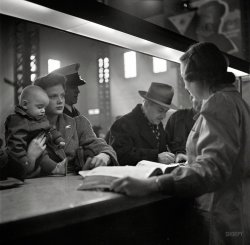
- Red Owl Supermarket
- ... in the U.S. This negative came together with a lot from New Orleans. I don't know the place. In the background I can see the Red Owl ... Posted by 4allofyou - 09/20/2011 - 1:41am -
![Red Owl Supermarket I received a lot of negatives from people in the U.S. This negative came together with a lot from New Orleans. I don't know the place. In the background I can see the Red Owl Supermarket. View full size.
Redfield, South DakotaAccording to a 1951 article in the Huronite and Daily Plainsman by the mayor of Redfield, Harlan P. Packard was one of the town's "first two bona fide settlers." He lured the State School and Home for the Feeble Minded (now called the South Dakota Developmental Center) to greater Redfield. "It is his name that is most indelibly linked with the city and its subsequent progress." The hotel, then the oldest building in town, is now gone. The Dakota Cafe building seems to remain, "renovated" into a hardware store.
Harlan Packard HotelGoogling turns up references to a number of (outdated, unfortunately) eBay listings for a postcard showing a Harlan Packard Hotel in Redfield, South Dakota, plus a listing in the Hotel & Motel Redbook for 1968 indicating an establishment by that name at the corner of 6th Avenue and Main in that city. Also, in the photo, note what is pretty surely the Dakota Cafe on the corner, and Redfield had one of those.
Harlan Packard HotelHow did you manage to find these answers because I couldn't.
[Google Books search. - Dave]
Dakota CafeThanks for your help, this is how the building looks today.
View Larger Map
Signal LightThe light on top of the Harlan Packard Hotel was the police signal. If you needed the police, you would call the telephone operator, and she would turn it on, and then you could call the telephone office to find out what the problem was. This method was used until the early 1960s.
Richard Gallup
Redfield, SD
Harlan Packard HotelThe Harlan Packard Hotel was my grandfather's. From the early 1930's until he died in the 1970's. My grandmother would run the desk (the old cable plug in types on the switchboard (remember Lily Tomlin's character from Laugh In?), and my father ran his shoeshine service in the lobby. As a kid I had the greatest pleasure possible -- free soda pop from the bar, and read as many comics as I could at one time.
Attached to the Hotel around the corner was the Prairie Lounge, one of two watering holes in the town.
Pheasant hunting was one of the major economic engines, with hunting parties from all over the US, often staying with farmers in the area - the original bed and breakfasts? - if not staying at the Harlan Packard.
Also important is the cafe next door. All the farmers within a very large radius chose to come to town every Thursday to get groceries, supplies, and a great deal of socialization. My treat was a bowl of mashed potatoes and gravy at the cafe -- no ice cream or other desserts, excepting perhaps a piece of pie -- and no comfort good could possibly have been better.
This was a small town of ~ 1200 when I was a boy, and it really hasn't changed a lot since except for new building facades, and of course, newer vehicles.
If you still have this photo, I would be interested in obtaining it. I don't hold much hope you do, since the last posting from you was in 2009.
What a wonderful picture and the memories it sparked.
Paul Blackburn
Phoenix AZ 85048
pablackburn@cox.net
(ShorpyBlog, Member Gallery, Eateries & Bars)](https://www.shorpy.com/files/images/img025_0.thumbnail.jpg)
- Artillery Hall Ball: 1910
- ... 1910. "Washington Artillery Hall, St. Charles Avenue, New Orleans." With signs advertising a "Fancy Dress and Masquerade Ball" given ... it may have descended from an earlier military unit in New Orleans.
The unit first saw combat during the Mexican War. The 1st ... Posted by Dave - 01/15/2018 - 11:37pm -
![Artillery Hall Ball: 1910 April 1910. "Washington Artillery Hall, St. Charles Avenue, New Orleans." With signs advertising a "Fancy Dress and Masquerade Ball" given by the Glad-U-Kum and Merry Widow social clubs on Shriners Night. View full size.
Ford, Bacon & Davis StreetcarBefore the more well-known green Perley streetcars, the St. Charles line used Ford, Bacon & Davis cars, built in the 1890s.
Here's of the one remaining FB&D cars, next to a traditional Perley of the 1920s. Also a great article, explaining the history.
https://gonola.com/things-to-do-in-new-orleans/history/nola-history-the-...
The Final SalvoWashington Artillery as a Buick dealership, with the regiment long gone, before final demolition in 1952
Glad-U-KumIn 2012, Shorpy showed us the Cathedral housing the
Washington ArtilleryOne of the oldest National Guard units in the United States, the Washington Artillery [by that name] traces its origins back to 1819, although it may have descended from an earlier military unit in New Orleans.
The unit first saw combat during the Mexican War. The 1st through 4th Companies saw combat in every major campaign of the Confederate Army of Northern Virginia, and the 5th Company saw combat in every major campaign in the Western theatre, from Shiloh to the final battles in Alabama.
The unit was mobilized during the war with Spain in 1898 but saw no action. It served on the Mexican Border in 1916-1917 in support of Pershing's Punitive Expedition, and saw action in France during WW1 [by this time it was officially known as the 141st Field Artillery Regiment].
It saw combat action in the Italian campaign during WW2, and continues as an active unit of the Louisiana National Guard to this day.
(The Gallery, DPC, New Orleans)](https://www.shorpy.com/files/images/SHORPY-4a23674a.thumbnail.jpg)
- Home Place: 1938
- ... chemical plants, that make the drive along the river from New Orleans to Baton Rouge a beautiful but occasionally startling experience. ... Posted by Dave - 08/30/2012 - 11:04am -
![Home Place: 1938 St. Charles Parish, Louisiana, circa 1938. "Home Place. Hahnville vicinity." 8x10 inch acetate negative by Frances Benjamin Johnston. View full size.
Beautiful Home PlaceHome Place, built in the 1790s, is one of the oldest plantation houses in Louisiana. It hasn't been inhabited in many years, and is in a state of advanced decay. Here's the house from a distance (via Google Images):
http://www.asergeev.com/pictures/archives/compress/2006/559/06.htm
Four years ago, I was working on a film shoot down the road, and our trucks were were parked on the plantation grounds. The owner of Home Place, a genteel 85-year-old who'd grown up in the house, offered to take us inside to see the ground floor wine cellar. But our schedule was tight, and we didn't have time — something I've regretted ever since.
ScaleThose columns on the porch are superb; very fine proportions, hard to duplicate today.
Woodstove owner's opinionThe two chunks of firewood lying on the ground in the foreground -- someone was splitting firewood there and decided they had enough wood for the moment. The rest of the firewood is stowed where it will stay dry, under the veranda and under the attached building at right (summer kitchen?)
Southern Decay"Home-Place is a near perfect example of a raised Creole plantation house." More here.
Columns and kitchens Anonymous Arkie is right; love the columns, but I have some questions about the brick ones holding up the house. Again we have a semi-detached kitchen.
Still standingThis looks like one of those casually wonderful plantations, nestled among the chemical plants, that make the drive along the river from New Orleans to Baton Rouge a beautiful but occasionally startling experience.
[Birthplace of Howard Johnson! - Dave]
Johnston's amazing gift Did Frances Johnston ever write about how she selected the perspectives and views for her photographs? Was it just her natural "eye" for the shot? She picks the most illuminating views. For instance, the standard photo of this fine 18th Century Creole plantation house is the head-on, symmetrical one which we see in the portrait shots from the Anonymous Tipsters.
But Johnston has chosen a rear-yard shot that reveals the inner working of the plantation, along with the wear-and-tear of life itself. The detached kitchen, the chickens pecking under the porch, the pillars losing stucco, the brick path that vanishes, the graceful yet now unpainted columns original to the house ... all give us a more vivid image of domestic life in that home more than any book could have ever done.
[She shot many views of each house. Lots of them including a finger in front of the lens. - Dave]
(The Gallery, F.B. Johnston)](https://www.shorpy.com/files/images/01463u1.thumbnail.jpg)
- Orders Neatly Boxed: 1940
- ... handlebars and rode around listening to WTIX out of New Orleans.
Western Auto also sold student-grade guitars and amps. Many of ... Posted by Dave - 12/26/2012 - 9:39pm -
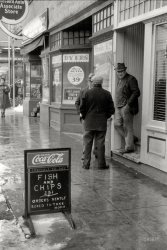
- Eight-Star Hotel: 1900
- New Orleans circa 1900. "St. Charles Hotel, St. Charles Street." Welcome NEA ...
Electric Lights For Editorial Luminaries The New Orleans Daily Picayune of March 1, 1900 contained two full pages describing ... on the St. Charles Here .
(The Gallery, DPC, New Orleans, Railroads) ... Posted by Dave - 07/07/2017 - 11:35am -
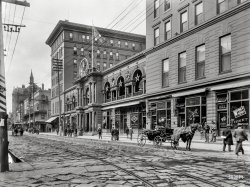
- The Courtyard: 1903
- New Orleans circa 1903. "Old Spanish courtyard." Is the bar open yet? 8x10 inch ... same. Fresh air (or what passes for it in Summertime New Orleans) and absinthe -- gracious living in the pre-Freon era.
Any ... the two brick/stucco pillars is?
(The Gallery, DPC, New Orleans) ... Posted by Dave - 07/25/2014 - 9:24am -
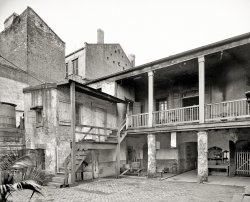
- Parlor Furniture: 1920
- New Orleans circa 1920. "Diamond antique store, Royal Street." Where Stella ... Antique antique store.
(The Gallery, Arnold Genthe, New Orleans, Stores & Markets) ... Posted by Dave - 02/23/2014 - 2:28pm -
![Parlor Furniture: 1920 New Orleans circa 1920. "Diamond antique store, Royal Street." Where Stella Kowalski shopped. Nitrate negative by Arnold Genthe. View full size.
Well, come on in!And have a look around, why don't you?
View Larger Map
I wonderif the sign painter was asked to paint many signs for the political and labor unrest crowd?
[Or if he had his own branded credit card. - Dave]
That's anAntique antique store.
(The Gallery, Arnold Genthe, New Orleans, Stores & Markets)](https://www.shorpy.com/files/images/SHORPY_7a03083a.thumbnail.jpg)
- Town Building: 1907
- ... also 5 miles. -tterrace]
Coming Soon Gorton's New Orleans Minstrels!
(The Gallery, DPC) ... Posted by Dave - 05/31/2013 - 10:44am -
![Town Building: 1907 Circa 1907. "Town Building, fire station and opera house -- Littleton, N.H." Coming Aug. 26: Gorton's Famous Minstrels. 8x10 glass negative. View full size.
First-Class Wooden Building
History of Littleton, New Hampshire, 1905.
James R. Jackgon
Annals. 1870—1903.
… In view of these facts and the further fact that the town and Village District are now paying as rent for insufficient and unsuitable accommodations for town and district office and business a sum much larger than would be required to pay the interest on any indebtedness which would be incurred in building a first-class wooden building with fire-proof vaults for town records suitable and convenient for all town and village purposes and which would be an ornament to the town, we recommend that the town vote to bond itself, for not exceeding $15,000.00, and instruct its Selectmen to purchase the Ladd and Bunker blacksmith shop lot, so called, situate on Union Street in Littleton village, provided it can be purchased at a reasonable price, and if not, cause the same to be condemned as a site for a town building, and to erect thereon, during the coming season, a handsome wooden building, containing a fire-proof vault for the town records, and finish therein a Town Hall, Selectmen's and town clerk's office, police court room and lobby, also for the temporary use of the town library until such time as a fire-proof library budding and memorial hall can be constructed by gift or otherwise; also suitable rooms for the fire department of Littleton Village District and for storage of its tools and other property, provided the Selectmen can make satisfactory arrangements with said district to lease the same.…
The report of the majority of the committee having been adopted, Daniel C. Remich moved, “That the Selectmen be instructed to purchase the Ladd and Bunker blacksmith shop lot, so called, situated on Union Street in Littleton Village, if it can be purchased at a reasonable price, and if not, cause the same to be condemned as a site for a town building, and to erect thereon during the ensuing season a handsome wooden building containing a fire-proof vault for the town records, and finish therein a Town Hall, Selectmen's and Town Clerk's office, Police Court room and lobby. Also provide therein suitable accommodations for the temporary use of the Town Library until such time as a fire-proof Library Building and Memorial Hall can be obtained by gift or otherwise. Also suitable rooms for the Fire Department of Littleton Village District and for storage of its tools and other property, provided the Selectmen can make satisfactory arrangements with said district to lease the same and to pay for said land and erect said building. The Selectmen are authorized and instructed to issue in behalf of the town not exceeding $15,000, of bonds bearing four per cent interest, payable in thirty years from date, with a right reserved in said bonds to pay the whole or any portion of said bonds after ten years from their date. In constructing the town building herein proposed local laborers shall be employed provided they can be secured at reasonable American wages, which is on the basis of $1.50 per day for a good common day laborer, and provided further that sufficient numbers can be obtained.”
Shout "fire" in a crowded theatreAs long as it's loud enough for the firemen downstairs to hear.
Under restoration! At least as of this Streetview shot:
View Larger Map
Mileages?I looks like they are installing screening on the cupola at the top of the building. From the amount of bird/pigeon droppings just below the weather vane, I can understand why they would.... or maybe to prevent lovers from leaping?
The hand sign pointing right that says: MILEAGES; what does that mean?
[Well, whatever else, they have low rates. -tterrace]
Re:Mileages?The "hand signs" pointed the way to the towns of Bethlehem, NH and Franconia, NH, both approx 5 miles down the road.
The "Mileages - Low Rates" was separate and was where you paid freight for the transportation of goods. Freight was assigned a rate per 100 lbs., depending on the commodity being shipped. Perhaps this is where they were provided rail distances between cities and the rates to transport different materials?
Total guess?
Restoration!It makes me so happy to hear that one of the beautiful buildings in one of these pictures has both escaped the wrecking ball. The fact that it is even being restored is even better!
Early Example?Multi-Use building. A three-in-one special. Cool.
"Mileages" SolvedFranconia is 5 miles due south of Littleton, NH.
Bethlehem is 5 miles due east/southeast of Littleton, NH.
What they apparently don't want you to know is that Franconia and Bethlehem are in neighboring Vermont.
[Around the corner there's another hand pointing in another direction to Bethlehem, also 5 miles. -tterrace]
Coming SoonGorton's New Orleans Minstrels!
(The Gallery, DPC)](https://www.shorpy.com/files/images/SHORPY_4a18372a.thumbnail.jpg)
- Free Hot Lunch: 1901
- ... phenom took place -- I’m thinking the 1970s? -- but in New Orleans it was common for neighborhood dives to offer red beans and rice to ... Posted by Dave - 08/27/2020 - 4:17pm -
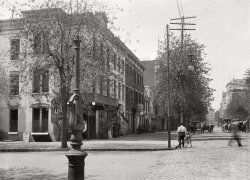
- The Elks: 1906
- Circa 1906. "Elks Place, New Orleans, Louisiana." Brought to you by Anna Held. Forgotten New Orleans: The old criminal court building and parish prison in the ... the right? Can we get a zoom-in?
(The Gallery, DPC, New Orleans) ... Posted by Dave - 05/14/2014 - 3:57am -
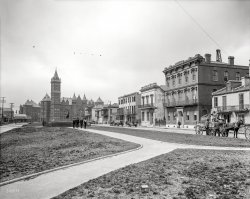
- Tannery Row: 1903
- New Orleans circa 1903. "Steamer loading hides." 8x10 inch dry plate glass ... for "Movember"!
(The Gallery, Boats & Bridges, DPC, New Orleans) ... Posted by Dave - 11/19/2012 - 3:14pm -
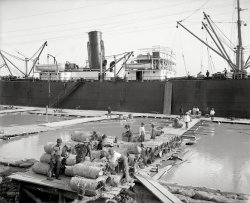
- First Class Sanitary Barber: 1935
- November 16, 1935. "New Orleans photographs -- 1123 Royal Street." Hi, Bob! Large-format ...
(The Gallery, Cars, Trucks, Buses, Gottscho-Schleisner, New Orleans) ... Posted by Dave - 03/31/2014 - 8:52am -
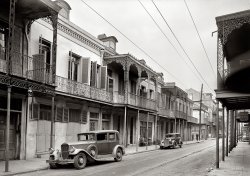
- Fat Tuesday: 1906
- 1906. "Mardi Gras in New Orleans. The Royal chariot with Rex at Canal Street ferry." 8x10 inch glass ... number of people are leaning on it.
(The Gallery, DPC, New Orleans) ... Posted by Dave - 02/28/2017 - 8:49am -
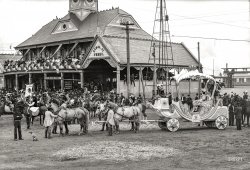
- S.S. Utica: 1910
- ... the Illinois River, and eventually the Mississippi to New Orleans.
The Quintay stranded and became a total loss on Penguin Island ... could move South out of Lake Michigan and down thru to New Orleans in the canal/river system.
[As noted below, the Utica was a ... Posted by Dave - 08/14/2012 - 8:50pm -
![S.S. Utica: 1910 Circa 1910. "Freighter S.S. Utica, New York Central and Hudson River Railroad Line." 8x10 inch glass negative, Detroit Publishing Company. View full size.
1904-1949Constructed by the Detroit Ship Building Co., this 325-foot package freighter was launched April 28, 1904, at Wyandotte for the Western Transit Company, the marine operation of the New York Central on the Great Lakes.
In 1915 the Interstate Commerce Commission, citing the 1912 Panama Canal Act, ruled that American railroads could not also engage in marine transportation, and the NYC (as well as Erie, Pennsylvania, and Lehigh Valley) sold their steamship operations on the Great Lakes. Many of the vessels were consolidated under a new firm, Great Lakes Transit Corporation, for which the Utica ran from 1916 until 1945. That year, GLTC sold her to Chilean interests who renamed her Quintay. She was towed down the Chicago River, the Chicago Sanitary and Ship Canal, the Illinois River, and eventually the Mississippi to New Orleans.
The Quintay stranded and became a total loss on Penguin Island in the Messier Channel, Chile, on April 28, 1949, on a voyage from Callao to Punta Arenas while carrying general cargo and drums of oil.
Steamship Utica
Beeson's Marine Directory of the Northwestern Lakes, 1908
Steamship Utica, built in 1904 for the Western Transit Co. of Buffalo, N.Y. Gross tonnage: 3533, length: 325 ft., beam: 44 ft.
HmmmmI wonder what the three planks on the side of the hull are.
[Docking fenders. - Dave]
Rounding the Eastern Continent?I was not aware a vessel of this size could move South out of Lake Michigan and down thru to New Orleans in the canal/river system.
[As noted below, the Utica was a Great Lakes freighter. - Dave]
(The Gallery, Boats & Bridges, DPC)](https://www.shorpy.com/files/images/4a16007a.thumbnail.jpg)
- Le Petit Theatre: 1937
- New Orleans circa 1937. "Le Petit Theatre du Vieux Carre, Chartres and St. ... American Institute of Architects.
Johnston moved to New Orleans in 1940 and entered a life of semi-retirement. Always independent, ... view
First!
(The Gallery, F.B. Johnston, New Orleans) ... Posted by Dave - 08/14/2012 - 3:52pm -
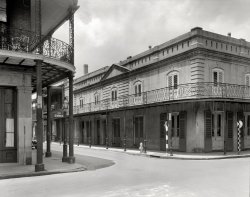
- Two Saints: 1910
- ...
Where two worlds meet Looks like a cross between New Orleans and any small town in France or Spain. Pretty appropriate, I guess, ... Posted by Dave - 06/12/2014 - 10:06am -
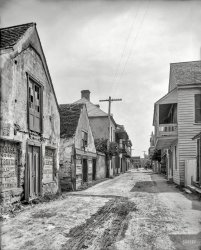
- Butter Eggs Cheese: 1925
- ... The one marked "USA 17574"? The building has a real New Orleans feel to it with that balcony. Nice picture.
[Center Market ... Posted by Dave - 08/05/2012 - 1:12pm -
![Butter Eggs Cheese: 1925 Washington, D.C., circa 1925. "Semmes Motor Co. -- National City Dairy Co. trucks." National Photo Company Collection glass negative. View full size.
Many topicsWhat an interesting building; when was it torn down in the name of 'progress'? Is that a U.S.Army car just after the subject trucks? The one marked "USA 17574"? The building has a real New Orleans feel to it with that balcony. Nice picture.
[Center Market was torn down in the 1930s to make way for the Constitution and Declaration of Independence. - Dave]
View Larger Map
Well, OkehThat's perfectly acceptable, it was in a very good cause!
Golden SheafI like a nice sheaf of butter on my morning toast.
Federal touring carThe first car to the left of the Golden Sheaf vans is painted on the back with the legend "U.S.A. 17574." Was that a federal car license number? Did that exempt it from needing a license plate for each state it was driven in?
[U.S.A. = United States Army. - Dave]
Golden Sheaf Butter
Washington Post, Apr 11, 1906
Company Incorporates
A $200,000 concern was yesterday incorporated by certificate filed with the recorder of deeds. The name of the corporation is the National City Dairy Company, formed for the purpose of carrying on a general commission business.
The incorporators are Edward O. Whitford, George L. Whitford, Shipley Brashears, Jr., Henry V. Tulloch, Arthur A. Birney, Fred B. Rhodes, and Samuel W. Curriden. The company will be located at No. 6 Wholesale Row, of the Center Market.
Always Fresh
Samples Will Be Served
Dodge TrucksAll of the trucks shown are Dodges, the first two are 1927 models, the next two date from 1925/26, and the very last is from 1923/24. note the changes in roofline, windshield and fenders over time, the oldest truck has thinner tires as well, as balloon tires were adopted industry wide during 1924-26
(The Gallery, D.C., Natl Photo, Stores & Markets)](https://www.shorpy.com/files/images/28405u.thumbnail.jpg)
- Jackson Square: 1903
- New Orleans circa 1903. "Jackson Square and St. Louis Cathedral." 8x10 inch dry ... restored in 2005, with some fanfare as is customary in New Orleans, to restore the original design.
[The cupola is present in a ... 1900, 1903 and 1906. - Dave]
(The Gallery, DPC, New Orleans) ... Posted by Dave - 10/14/2020 - 4:08pm -
![Jackson Square: 1903 New Orleans circa 1903. "Jackson Square and St. Louis Cathedral." 8x10 inch dry plate glass negative, Detroit Photographic Company. View full size.
Question about the dateI am wondering about the 1903 date. The buildings on either side of the St. Louis Cathedral are the Cabildo to the left and the Presbytere to the right. The Cabildo has a prominent cupola in the photo but the Presbytere does not, although the roof appears to be patched in the center where it should be.
The two buildings were designed to look alike in the 1790s, two stories with a flat roof. The Cabildo was completed first with the Presbytere's construction lagging a bit. A flat roof proved to be a mistake in such a rainy environment, so a third floor with a mansard roof was added to both in 1847 along with a cupola to complete the matching design. The Presbytere's cupola lasted until September 29, 1915 when a then unnamed hurricane destroyed it. The cupola was finally restored in 2005, with some fanfare as is customary in New Orleans, to restore the original design.
[The cupola is present in a view from Detroit Photographic's 1898 catalogue, but missing in photos dated 1900, 1903 and 1906. - Dave]
(The Gallery, DPC, New Orleans)](https://www.shorpy.com/files/images/SHORPY-4a06516a.thumbnail.jpg)
- Natchez at Nawlins: 1903
- ... River circa 1903. "Packet steamer Natchez at New Orleans." 8x10 inch dry plate glass negative, Detroit Publishing Company. ... peeled off.
(The Gallery, Boats & Bridges, DPC, New Orleans) ... Posted by Dave - 08/17/2017 - 2:12pm -
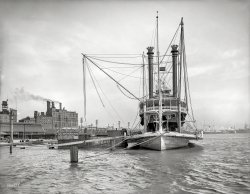
- Public Health: 1914
- ... is best known to posterity as the military governor of New Orleans and for the harsh and tyrannical severity of his regime. In fact ... Posted by Dave - 08/23/2012 - 5:35pm -
![Public Health: 1914 Washington, D.C., circa 1914. "U.S. Public Health Service and Geodetic Survey Library, B Street and New Jersey Avenue S.E." Where Charles Addams meets Edward Gorey. Harris & Ewing Collection glass negative. View full size.
Now Longworth Bldg.I am surprised by the prominence of the site of this building on Capitol Hill: It would seem that, at that time, public health and scientific exploration were held in greater esteem compared to today. This is now the site of the Longworth House Office Building.
Another location added to my Google Maps mashup of Shorpy D.C. architecture.
View Larger Map
Paging Dr. FrankensteinWhat's on top of the building that looks like an old TV antenna? The box sitting near the lamp post is also a mystery to me.
[It's a wireless mast (radio antenna). The mailboxy thing to the right of the lamppost is labeled "waste paper." - Dave]
Institutional MindsetOne of the commonplaces of design is that architects can seldom do better than their clients demand. The Butler mansion looks as if Butler was raised in an orphanage, or at the least, a grimly expensive private school.
Butler MansionThe following 1931 article accompanied a similar photo. Incredibly, this building was constructed as a pair of private residences in 1889. The granite of the structure is from Cape Ann, Massachusetts, brought to D.C. as ballast in sailing vessels arriving to load coal. The building was purchased by the federal government for $275,000 in 1891.
To the left is the Richards Building, put up in 1871. Its first occupant was the Coast and Geodetic Survey. The government initially leased the property until finally purchasing it for $155,000 in 1891.
Washington Post, Dec 14, 1931
The above picture depicts the old Butler mansion, which once housed the United States Public Health Service, located at 3 B street southeast. It has since been razed.
The establishment was built by the late Maj. Gen. Benjamin Butler, the stormy petrel of the Federal Army during the bitter years of the Civil war. After the close of the conflict he desired a place where he might retire from the turbulent strife of battlefield and public life, and write his colorful, if vitriolic memoirs.
Gen. Butler is best known to posterity as the military governor of New Orleans and for the harsh and tyrannical severity of his regime. In fact so bitter were the proponents of the Confederacy toward his rule that Jefferson Davis ordered him captured and hung as a common felon.
Long before his participation in the Civil War he was leader of the radicals in the Massachusetts Legislature, later being elected to Congress. He also served under Gen. Grant at Richmond and Petersburg.
Later the stately mansion was occupied by Chester A. Arthur, during the first few months of his administration, and after passing through many hands, became the home of the United States Public Health Service.
Washington Post, Feb 17, 1889
Gen. B.F. Butler has not lost faith in Southeast Washington. He has purchased the old Gulick mansion at 222 New Jersey avenue southeast, and is having it remodeled, making two complete houses. The cost of the work will be $10,000. The house No. 222 will be occupied by the niece of the General, and he will himself have an office room on the first floor. This house will contain thirteen rooms and will be heated by steam. The elaborate old marble mantels of the Gulick house are retained in the parlors, while mantels in the other rooms are of tile and antique oak. The hall is eight feet wide and extends back to the dining room, while the stairway leads from the front parlor door line to the second story landing. The newel posts, balusters and stair rails are of ash. The second and third floors are supplied each with bathroom. The first floor is four rooms deep, the second parlor to be occupied by Gen. Butler as an office room. The entire house will be heated by steam. the house No. 222½ will contain twelve rooms and will finished in a similar manner to the one just described. This house, it is understood, will be rented when ready for occupancy.
MaterialWhat do they DO with all the 'stuff' when they tear down a building this size?? I mean, look at that thing! HUGE stone blocks, giant slabs of concrete...where does it all go? It can't just go into the landfill, can it? When I see the modern Google version of these Shorpy sites I first wonder a) what in the hell were they thinking, and b) what did they do with the mountain of debris. Thank you and good night.
[C&D (construction and demolition) debris is one of the top landfill components. As for the "modern version" of what's there, I think the current building looks a lot nicer. - Dave]
No Place Like HomeI'm usually a fanatic for historic preservation, but even I have to say that the Butler Mansion is the least homey home I've ever seen. It has "administrative building" chisled all over it.
(The Gallery, D.C., Harris + Ewing, Medicine)](https://www.shorpy.com/files/images/13557a.thumbnail.jpg)























